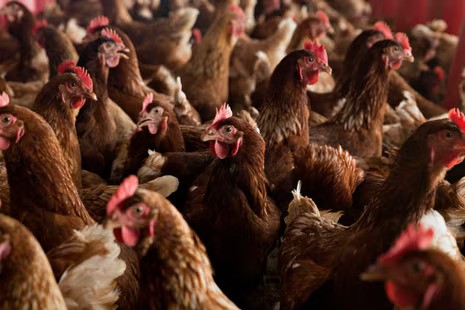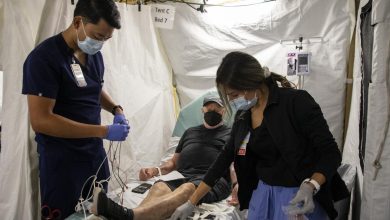Extreme heat may be crucial factor in human spread of bird flu

As authorities continue to monitor the virus’s transmission, extreme temperatures may have a significant role in the largest bird flu outbreak among humans in the United States.
Worker personal protective equipment (PPE) contaminated with the highly pathogenic H5N1 avian flu in Colorado most likely malfunctioned due to a heatwave. According to officials this week, four people have tested positive for H5N1, and a fifth person’s case is anticipated to be confirmed as bird flu.
This is the first time that the US has heard of a large number of human cases of avian flu.
It has also been challenging for employees on dairy farms to wear PPE, partly due to the heatwave that has swept throughout most of the United States. Earlier this month, Colorado confirmed that a dairy worker had contracted avian flu.
Profound heatwaves across the nation have been connected to climate change, which experts fear can intensify epidemics of fatal diseases like these. The appearance and increased dissemination of viruses such as H5N1-infected wild birds, as well as their changing migratory patterns, have also been related to climate change.
According to Alexandra Phelan, an associate professor at the Johns Hopkins Bloomberg School of Public Health, “small shifts can have seismic impacts, sometimes in unexpected ways,” when you alter a global system as fundamentally as the climate.
Workers in Colorado were removing a flock of laying hens from the flock after they tested positive for H5N1.
They killed a few dozen birds at a time with carbon dioxide gas, catching each one, loading it into a wagon, and proceeding bird by bird.
At a press conference on Tuesday, Julie Gauthier of the US Department of Agriculture’s (USDA) Animal and Plant Health Inspection Service stated, “It’s a very, very manual – difficult, laborious process.”
Additionally, working in such close quarters for extended periods of time with animals sick with avian flu, which has a 50% fatality rate among humans, can be harmful.
The temperature outside was 104F (40C), but inside the chicken houses it was much hotter.
According to Nirav Shah, principal deputy director of the US Centers for Disease Control and Prevention (CDC), workers were unable to keep protective goggles and masks sealed on their faces due to the sweat and the massive industrial blowers used to prevent even greater temperatures. According to Shah, the fans also disperse dirt and feathers, which might disseminate the virus high in the air.
Out of the 160 employees at the farm, 60 later experienced symptoms, and five either tested positive or are thought to be positive. At the Colorado state health lab, the remaining fifty-five workers tested negative for H5N1, and several of them were given diagnoses for other respiratory conditions. We only tested employees who had symptoms.
Shah stated, “It is important to note that additional cases may be detected as the epidemiological investigation proceeds.”
at the following 10 to 14 days, workers will continue culling the 1.8 million chickens that make up the flock, according to Eric Deeble, acting senior advisor for H5N1 response at USDA, who made this announcement at the briefing.
According to Deeble, “the USDA believes that depopulation is crucial to halting viral amplification and shedding, halting future spread, and lowering the viral load in the environment.” “Workers would still need to feed and care for animals if depopulation were to halt, increasing their risk of exposure.”
When working with diseased hens, those engaged in culling on the farm, such as poultry producers, workers, contractors, and USDA employees, must wear Tyvek suits, N95 respirators, goggles, boots, and gloves.
Colorado notified the CDC right once after learning of suspected instances in humans, and the CDC sent a team of ten specialists, including an industrial hygienist, to develop protocols to lessen the risk of exposure for the workers as they handled the infected birds, according to Shah.
Shah stated that, in contrast to previous outbreaks at farms around the nation, where the CDC has usually had restricted access to afflicted animals and people, the CDC and the state of Colorado “have been joined at the hip.”
The dairy herds that tested positive for avian flu are located in the same county as the poultry enterprise.
The outbreak in dairy cows appears to have spread from cows to chickens and now to humans, albeit how exactly is still unknown. Genomic sequencing reveals a strong relationship between these patients and the outbreak. According to a USDA report from Michigan last month, individuals may be able to spread the virus from farm to farm.
Human health may suffer as a result of climate change, which also alters animal relationships and migration patterns that may increase the likelihood of extreme weather and spillover occurrences.
Indeed, it could be the cause of the H5N1 pandemic in the Americas.
Wild birds that were infected with the virus were able to travel from northern Europe to Iceland and then to Newfoundland in late 2021.
Professor of veterinary medicine at the University of Montreal Jean-Pierre Vaillancourt stated, “One reason it happened is because of unusually strong winds.” He noted that while it’s “extremely unusual” for the birds to be able to go so far, “we had really unusual climate conditions when this happened.”
It goes beyond the intense heat. Vaillancourt stated, “It’s the fact that you have atypical climate events.” “It might interfere with regular migratory patterns” as well as other actions by people and animals, creating additional potential dangers.
Since 2022, when a convict tested positive after culling sick hens in Colorado, these are the first incidents involving US poultry workers.
According to Shah, the five employees in 2024 also reported more conventional flu symptoms including fever, chills, coughing, and sore throats, in addition to conjunctivitis, sometimes known as “pink eye,” and teary eyes. They are all on the mend, he continued, and none of them needed to be admitted to the hospital.
The CDC has not modified its policy for dealing with farm outbreaks or its risk assessment for the general public, including vaccination recommendations.
Shah stated, “Given the mild symptoms that have been reported thus far and the lack of changes to the virus’s genetic makeup, the CDC is not recommending H5 specific vaccination for livestock workers.”
There is also research being done on cow vaccines.
According to Deeble, “We do believe that we can eliminate this within the dairy herds.”
“Improving biosecurity would enable us to halt the disease’s spread, and ideally, a vaccine will be developed in the future to aid in the disease’s complete eradication from the country’s herds,” he stated.
When responding to and possibly getting rid of infections like these, officials must keep the climate in mind, according to Phelan. “Governments must aggressively and urgently go beyond surface-level integration of climate considerations into all health and safety measures in all areas.”




